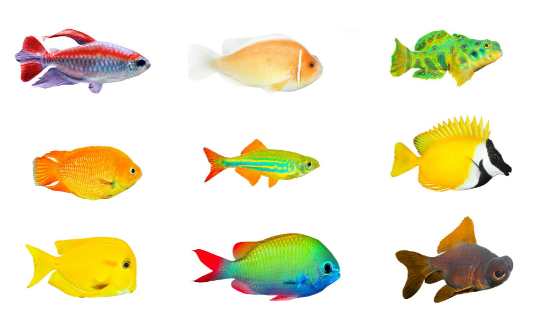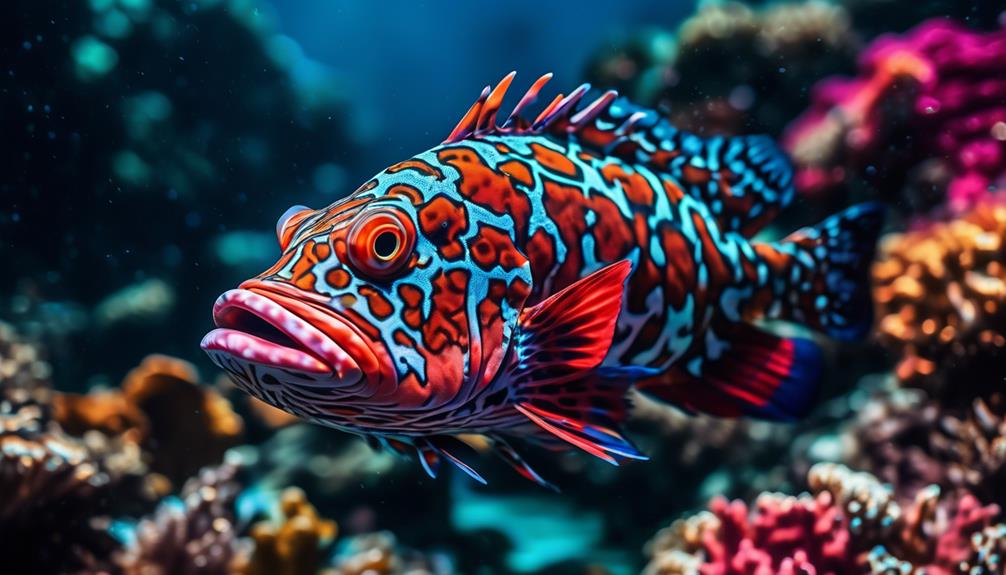
As you step closer to the aquarium, a burst of vibrant colors catches your eye. It’s as if a hidden world has come alive right before you, beckoning you to explore its depths.
Groupers, with their mesmerizing hues and majestic presence, are the stars of this underwater spectacle. But there’s more to these fascinating creatures than meets the eye. From their impressive size and unique physical features to their origins in the Indo-Pacific Ocean, groupers have a story to tell.
So, are you ready to dive deeper into this captivating world and uncover the secrets of these colorful and majestic fish?
Key Takeaways
- Groupers are saltwater fish that vary in size and have vibrant colors and complex patterns on their bodies.
- They require large aquariums with open swimming spaces and hiding places and should be fed a varied diet to meet their nutritional needs.
- Overfishing, habitat destruction, and climate change are major threats to grouper populations.
- Conservation measures, sustainable fishing practices, and habitat preservation are essential for the survival of groupers.
Size and Appearance
Groupers are a family of saltwater fish that come in various sizes, ranging from a few feet to well over 9 feet in length. Most aquarium varieties, however, grow to around 12 inches in length. They’ve stout bodies and oversized mouths, making them quite impressive to look at.
Originating primarily from the Indo-Pacific Ocean, groupers are known for their vibrant colors. They’ve complex patterns and markings on their bodies, showcasing shades of red, yellow, orange, blue, green, purple, brown, white, and black.
When considering groupers for your aquarium, it’s important to keep in mind their potential size. They require large aquariums with open swimming spaces and hiding places. Additionally, it’s best to avoid housing them with smaller fish but they can coexist peacefully with larger species of fish and other groupers.
Origins
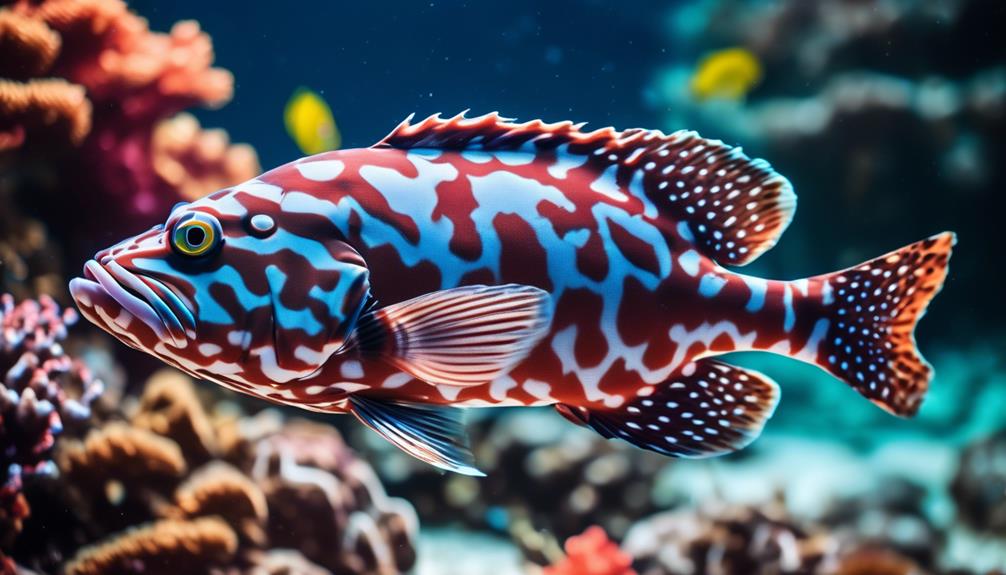
Originating primarily from the Indo-Pacific Ocean, groupers are known for their vibrant colors. They are a large family of saltwater fish, varying in length from a few feet to well over 9 feet. In aquariums, they usually grow to around 12 inches in length. Groupers have stout bodies and oversized mouths, making them quite distinctive. To emphasize the diversity of grouper colors, here is a table showcasing their shades:
| Color | Examples of Grouper Species |
|---|---|
| Red | Strawberry Grouper, Red Hind |
| Yellow | Yellowfin Grouper, Tiger Grouper |
| Orange | Orange-Spotted Grouper, Tiger Grouper |
| Blue | Blue and Yellow Grouper, Blue-Spotted Grouper |
| Green | Green Grouper, Greenback Grouper |
| Purple | Purple Grouper |
These are just a few examples of the colorful range that groupers exhibit. Their vibrant hues and intricate patterns make them captivating creatures to observe in the underwater world.
Color
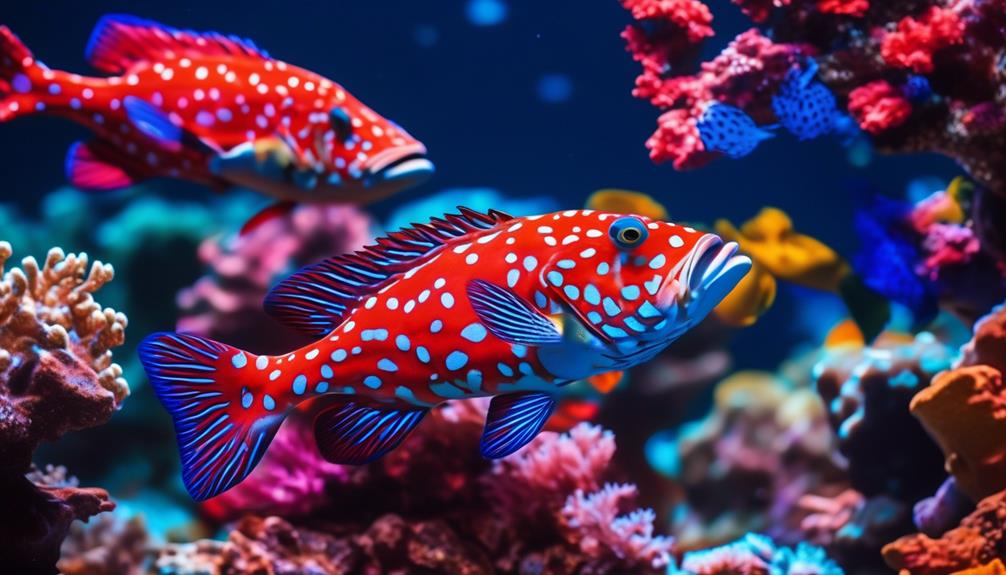
The vibrant colors of groupers make them a visually stunning addition to any aquarium. Just imagine the captivating sight of these majestic creatures swimming gracefully in a sea of vibrant hues. Here are five reasons why the colors of groupers are truly mesmerizing:
- Complex patterns and markings: Groupers display intricate patterns and markings on their bodies, adding a touch of elegance to their appearance.
- Diverse color palette: From fiery reds and striking yellows to vivid oranges and deep blues, groupers come in a wide range of captivating colors.
- Brilliant shades: The greens, purples, browns, whites, and blacks found in different grouper species contribute to their overall breathtaking beauty.
- Colorful variety: With so many different species, each with its own unique coloration, there’s always a grouper to suit every aesthetic preference.
- Eye-catching contrast: The vibrant colors of groupers create a stunning contrast against the backdrop of the aquarium, instantly drawing attention and admiration.
Maintenance and Care
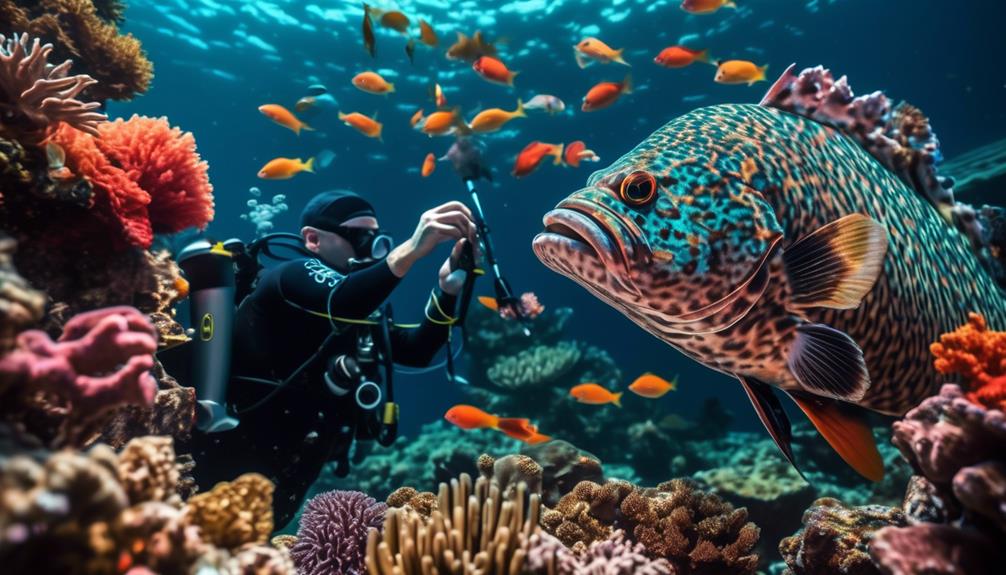
When caring for these vibrant and captivating groupers, it is essential to consider their maintenance needs. Groupers require very large aquariums with open swimming spaces and hiding places. They should not be housed with smaller species of fish, as they can become aggressive towards them. However, they can coexist peacefully with larger fish and other groupers. To reduce aggression, it is recommended to change the aquarium’s decor when introducing a grouper. In terms of feeding, groupers are carnivores and should be fed a varied diet of live and frozen foods, such as shrimp, baitfish, scallops, and squid. Here is a table summarizing the key points to keep in mind when maintaining and caring for groupers:
| Maintenance Needs | |
|---|---|
| Aquarium Size | Very large with open spaces and hiding places |
| Compatibility | Not suitable for smaller fish, but can coexist with larger fish and other groupers |
| Decor Changes | Recommended when introducing a grouper to reduce aggression |
Remember to provide a varied diet of live and frozen foods to meet their nutritional needs.
Feeding
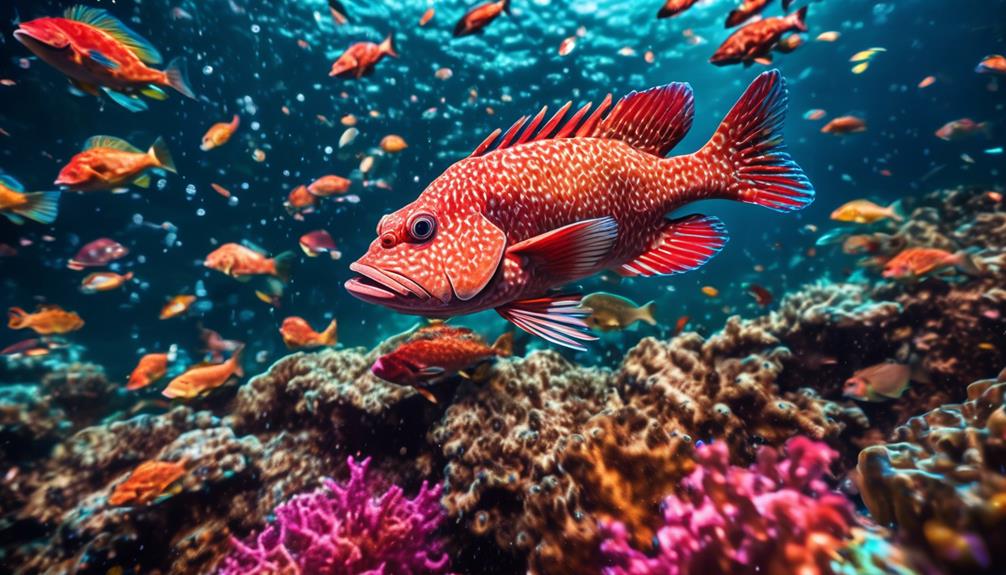
To ensure the proper care and nutrition of groupers, it’s important to provide them with a varied diet of live and frozen foods. Here are five key items to consider when feeding groupers:
- Shrimp: Groupers love the taste of shrimp and it provides them with essential nutrients.
- Baitfish: Adding small fish like anchovies or sardines to their diet will help simulate their natural feeding behavior.
- Scallops: These shellfish are a great source of protein and are easily digestible for groupers.
- Squid: Rich in vitamins and minerals, squid is a favorite food among groupers.
- Variety: It’s crucial to offer a diverse range of foods to meet all of the grouper’s nutritional needs.
Habitat
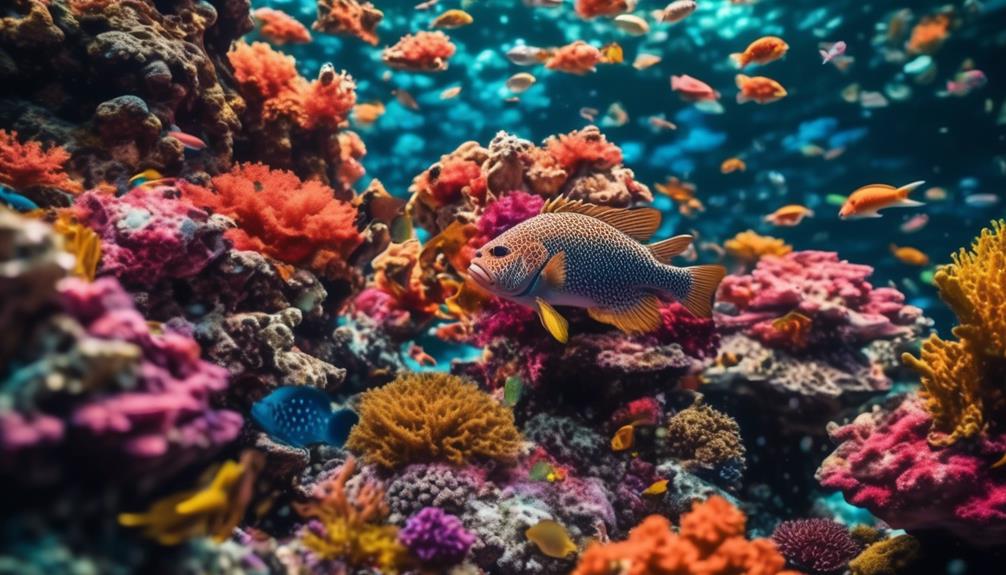
Groupers thrive in a habitat that replicates their natural environment. To ensure their well-being, it is important to provide them with a spacious and suitable aquarium. Here is a table to help you understand the key aspects of their habitat:
| Aspect | Description |
|---|---|
| Size of Aquarium | Groupers require large aquariums with open swimming spaces and hiding places. |
| Tank Mates | Avoid housing groupers with smaller fish species. They peacefully coexist with larger fish and other groupers. |
| Decor | Changing the aquarium’s decor when introducing a grouper can help reduce aggression. |
| Water Parameters | Groupers prefer saltwater with a temperature between 75-82°F and a pH level of 8.1-8.4. |
| Filtration | Invest in a high-quality filtration system to maintain water quality and remove waste. |
| Lighting | Provide appropriate lighting to mimic their natural environment. |
Reproduction
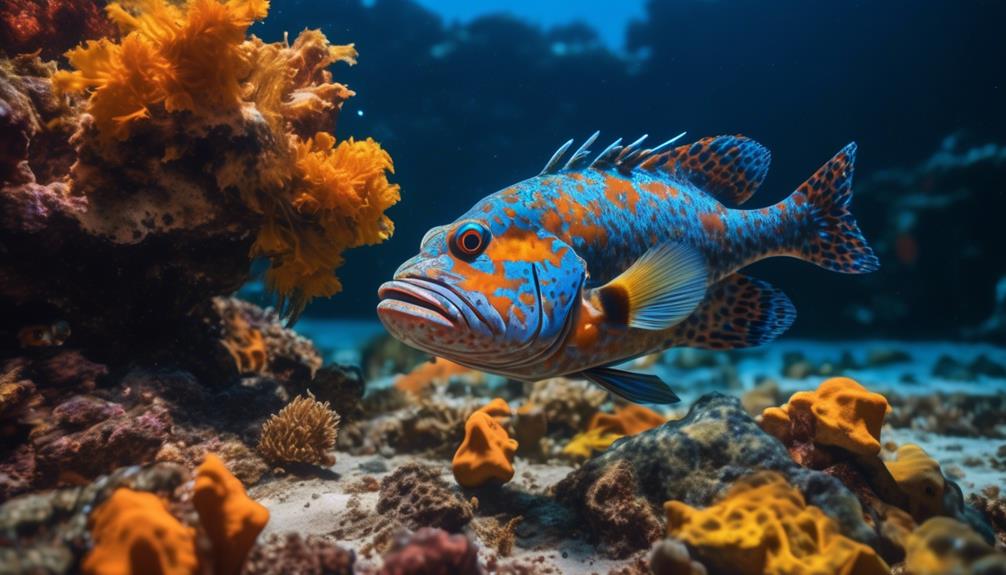
As we move on to discussing the fascinating topic of reproduction, it’s important to understand how groupers continue their life cycle in their carefully maintained aquarium habitat. Here are some key points to grab your attention:
- Groupers have a unique reproductive strategy.
- They’re protogynous hermaphrodites, meaning they can change their sex during their lifetime.
- When a dominant male is absent, the largest female in a group will transform into a male.
- Male groupers use booming vocalizations to attract females during spawning season.
- Spawning occurs in large aggregations, where thousands of eggs are released into the water column.
The reproductive behavior of groupers is truly remarkable and adds to their overall allure.
Understanding their reproductive cycle is essential for successful captive breeding programs and the conservation of these majestic creatures.
Interesting Facts
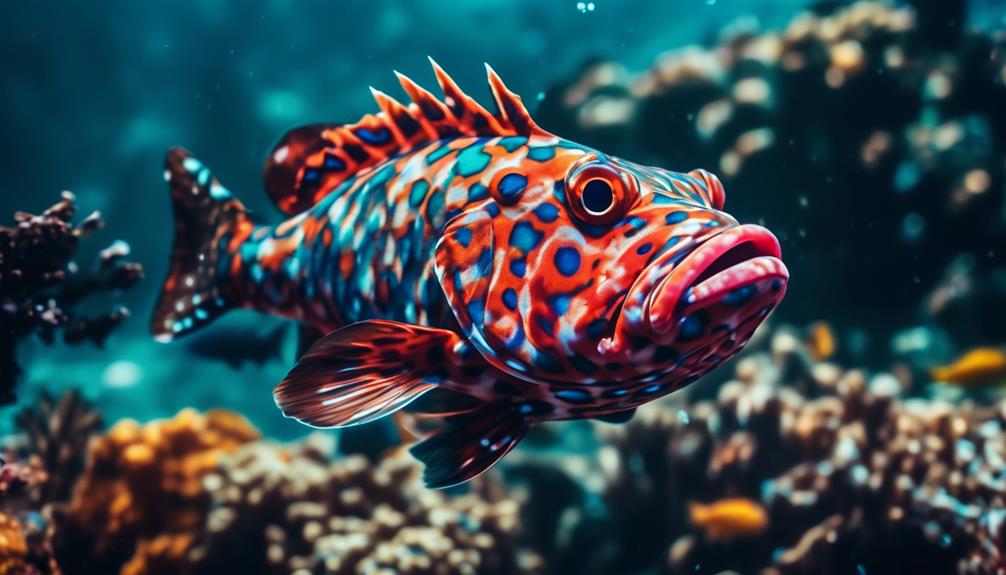
Did you know that groupers have the ability to change their sex during their lifetime? It’s true! Groupers are protogynous hermaphrodites, which means they start their lives as females and then later transition into males. This unique trait allows them to adapt to changes in their environment and maximize their reproductive success.
Another interesting fact about groupers is their impressive lifespan. Some species of groupers can live for over 50 years, making them one of the longest-living fish in the ocean.
Additionally, groupers are known for their intelligence and hunting skills. They use their large mouths and powerful jaws to swallow their prey whole, often ambushing them with lightning-fast strikes.
These fascinating facts make groupers even more intriguing and captivating creatures to learn about.
Conservation Status
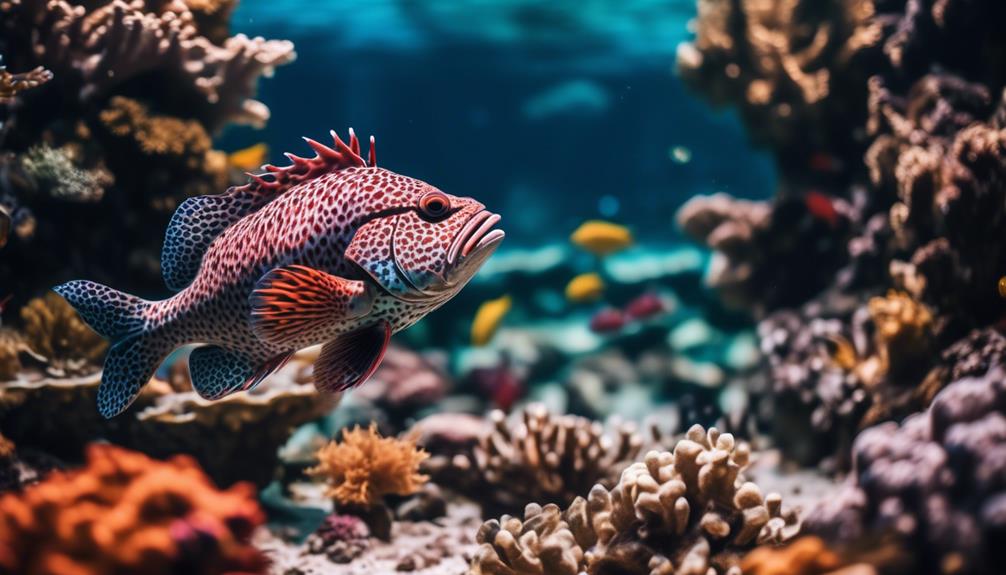
The conservation status of groupers is a topic of concern for marine biologists and environmentalists alike. With their vibrant colors and majestic presence, these fish play a crucial role in the health of coral reefs and marine ecosystems.
However, several factors threaten their survival:
- Overfishing: Groupers are highly prized in the culinary world, leading to overfishing and population decline.
- Habitat destruction: Coastal development and destructive fishing practices destroy the coral reefs and seagrass beds that groupers rely on.
- Climate change: Rising ocean temperatures and ocean acidification disrupt the delicate balance of marine ecosystems, affecting grouper populations.
- Illegal trade: The illegal trade of groupers for aquariums and traditional medicine further depletes their numbers.
- Lack of conservation measures: Insufficient regulations and enforcement contribute to the ongoing decline of grouper populations.
To ensure the future of these magnificent creatures, it’s essential to implement sustainable fishing practices, protect their habitats, and raise awareness about the importance of grouper conservation.
Frequently Asked Questions
Are Groupers Suitable for Smaller Aquariums or Do They Require a Large Tank?
Groupers require a large tank due to their potential size. They need open swimming spaces and hiding places. They should not be housed with smaller fish, but can coexist peacefully with larger species.
Can Groupers Be Kept With Other Species of Fish in the Same Aquarium?
Yes, groupers can be kept with larger species of fish in the same aquarium. However, they should not be housed with smaller fish. It’s important to provide them with a large tank and plenty of hiding places.
What Can Be Done to Reduce Aggression When Introducing a Grouper to an Aquarium?
When introducing a grouper to your aquarium, reduce aggression by changing the decor. Provide large swimming spaces and hiding places. Avoid housing them with smaller fish, but they can peacefully coexist with larger species.
What Types of Food Should Be Included in a Grouper’s Diet?
To keep your grouper healthy, include a varied diet of live and frozen foods like shrimp, baitfish, scallops, and squid. These carnivorous fish need a nutritious meal plan to thrive in your aquarium.
Do Groupers Have Any Unique Behaviors or Characteristics?
Groupers have unique behaviors and characteristics. They are known for their large size, colorful patterns, and oversized mouths. They need large aquariums and should not be housed with smaller fish. They are carnivorous and require a varied diet.
Do Groupers and Danios Have Similar Colorful and Majestic Qualities?
Groupers and danios both exhibit stunning and vibrant qualities. While groupers are known for their bold and striking colors, danios also contribute to the vibrant world of danios with their own array of bright and beautiful hues. Both species bring a majestic and colorful presence to the underwater world.
Conclusion
So, now you know why groupers are truly mesmerizing creatures in the underwater world.
Their vibrant colors and majestic presence make them a captivating addition to any aquarium.
Remember to provide them with ample space, compatible tank mates, and a carnivorous diet to ensure their well-being.
With their impressive size and complex patterns, groupers are a true testament to nature’s artistry.
Dive into the world of groupers and be amazed by their beauty and grace.




